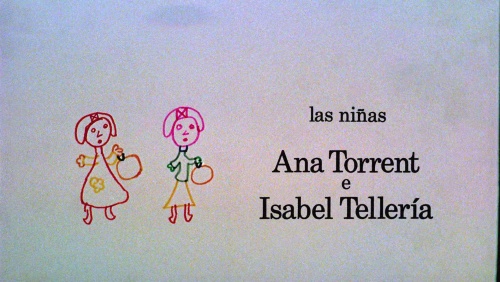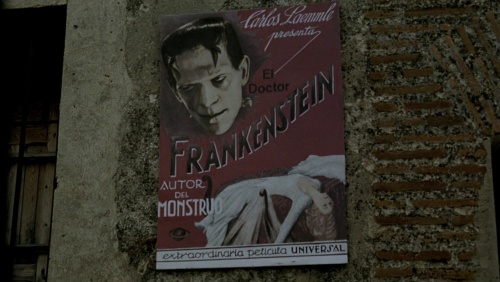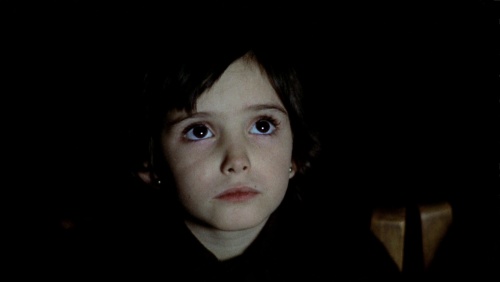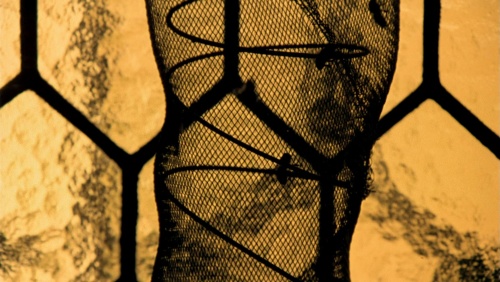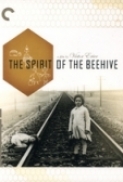
Year: 1973
Country: Spain
Director: Víctor Erice
Cast: Fernando Fernán Gómez, Teresa Gimpera, Ana Torrent, Isabel Tellería
IMBD: Link
Language : Spanish
Subtitles : English, Spanish, Italian

The Spirit of the Beehive was controversial from the start. Although it won the main prize at San Sebastián on its release, the jury’s enthusiasm was not shared by all the public. Some of the audience, restless at the film’s slow pace, even booed. Yet The Spirit of the Beehive is a classic example of one strand of Spanish filmmaking at that time. Like many repressive regimes, Francoism attempted to use cinema to change its negative image abroad and to create the impression that freedom of expression was permitted. By producing some internationally successful "quality" films, the regime also hoped to raise the status of Spanish cinema generally, which was at that time dominated by crude, mainstream comedies. By the early seventies, these policies had led to the production and export of many experimental and even discreetly oppositional films, although, of course, no overtly leftist movies could be made. The gaping holes in the plot of The Spirit of the Beehive and the mysterious motivations of its characters are typical of this "Francoist aesthetic," a term used to describe artistically ambitious movies of the time that made use of fantasy and allegory. These characteristics, which remain so magical to modern audiences, were used in the period as a form of indirect critique.
What is unique about The Spirit of the Beehive is its reference to the horror genre. The enigmatic plot begins with two children, Ana and her sister Isabel (Isabel Tellería), watching James Whale’s Frankenstein in an improvised cinema in the village of Hoyuelos (like the actors, the location keeps its real name in the film). Obsessed with a spirit who her sister claims lives nearby, Ana will set out one night to meet him, with near tragic consequences. Erice recently recounted that when the child actress confronted his re-creation of Frankenstein’s monster on set, she was as deeply disturbed as her character is in the film.
Ana Torrent’s dark-eyed infant, mesmerized by the monster, was thought to be especially Spanish in her looks and was compared by critics to a Goya portrait. Her innocence is counterbalanced by the hard-won experience of her father, played by veteran Fernando Fernán Gómez. The latter’s fond familiarity to Spanish audiences (he had already played in more than one hundred films and would appear in one hundred more) helped to humanize the somewhat chilly austerity of the film’s form.
He is first glimpsed in the beekeeping mask that gives him the air of an astronaut (the bare Castilian landscape is also lent a lunar quality), and this existential isolation seems similar to that of Erice, who has often spoken of the intensely personal nature of his cinema and the purity of his self-expression. Indeed, Erice and coscreenwriter Ángel Fernández Santos (later a distinguished film critic) based the script on their own memories, re-creating school anatomy lessons, the discovery of poisonous mushrooms, and the ghoulish games of childhood. It is no accident that the film is set in 1940, the year of Erice’s own birth.
Early versions of the script are both more explicit and more political than the final film. Originally, the story had a frame narrative in which the adult Ana explained in voice-over the mysteries that she could not fathom as a child (The South would retain such a voice-over). Likewise, the opening sequence, which is now limited to the arrival of the traveling cinema in the village, was at first intended to include shots of abandoned cannons and battered army boots, a clear reference to the tragedy of the civil war. The question of how political The Spirit of the Beehive is has been hotly debated since the film’s premiere, when leftist critics attacked its lack of overt commentary. Yet to equate Franco and Frankenstein as twin masters of horror is too crude. By focusing not on national conflict but on domestic distress, what one reviewer called "the war behind the window," Erice gives a much more subtle and moving take on the historical trauma suffered by Spain in the twentieth century.
That trauma is signaled in coded references. The village may be a playground for heedless children, but its unpaved streets and ruinous buildings are scarred by conflict and deprivation. The father, Fernando, listens in secret to a shortwave radio (surely it is to the BBC, forbidden by the regime), while his wife, Teresa (Teresa Gimpera), writes letters to an absent loved one (an envelope is addressed to a Red Cross camp in France, where Spanish refugees were interned). The character known only as "the fugitive," whom Ana visits in an abandoned barn, is presumably a member of the maquis, or anti-Francoist resistance. More generally, the insistent melancholia, approaching catatonia, of the household marks it out as one inhabited by members of the losing side in the war. As the innocent Ana leafs through the family photo album, we glimpse her father in a snapshot with Miguel de Unamuno, the famous intellectual who was a brave critic of Franco’s rebellion.
Erice conveys all this with great economy and reticence. The script is laconic (many of the best sequences are entirely silent), and the shooting style says it all. Each member of the family is introduced separately, in a different location: the spartan cinema, the teeming beehive, the hushed room, reminiscent of Vermeer, where Teresa writes her letter to an unknown man. Not once in the film’s ninety-nine minutes do they share the same frame. Typically, in the one sequence when all four are together, a family breakfast, Erice films each of them on their own. Because Erice rarely gives us an establishing shot to set up the action in such scenes, we feel as lost and disoriented as his child protagonist. Framing, too, is used to suggest existential isolation. In one moving sequence, when Fernando joins his wife in bed, she feigns sleep. Erice trains his camera on her watchful, fearful face, while her husband is reduced to indistinct offscreen noise and murky shadows cast on the bedroom wall.
The house itself, an authentic location, is perhaps the most important character in the film. The weathered stone facade, its large entrance crowned by a timeworn coat of arms, suggests an ancestral residence gone to seed (there are even battlements on the roof where Ana’s mother calls out to her lost daughter). Dark furniture is matched by gloomy oil paintings, carefully chosen for their themes: in the girls’ bedroom, an angel leads a child by the hand (Ana will become obsessed with death); in Fernando’s study, where he reads and types, Saint Jerome is depicted as a writer, with a skull placed prominently on his desk. Even the honey-colored light that streams through the windows, glazed with hexagonal panes, is more ominous than it first seems. It evokes the beehive of the title, which Fernando tells us is a society of feverish, senseless activity, one that has no tolerance for disease or death. Cuadrado’s cinematography thus cites a tradition of Spanish old masters that sees intimations of mortality not just in shadows but also in the vanity of everyday life. Ambitiously aiming his first feature at the heart of Spanish cultural tradition, Erice even has his opening title (“A village on the Castilian plain”) echo the first words of Spain’s national novel, Don Quixote (“In a place in La Mancha”).
Less evident, but no less exciting and innovative, is The Spirit of the Beehive’s sound design. Spanish films of the period generally used postdubbing for dialogue. The many child heroes of popular pictures were voiced by adult women shrilly impersonating infants. It is difficult to imagine now the shock felt by audiences on hearing real children’s voices, recorded live on location. Indeed, some complained that the atmospheric scenes where the children talk in whispers were inaudible. Elsewhere, Erice uses sound to cite the horror genre. As the children whisper about spirits (a candle flickers perilously between them), ominous clumping noises are heard offscreen (we later realize that it is just the father pacing the bare boards in an adjoining room). The original soundtrack, by acclaimed classical composer Luis de Pablo, combines uncanny melodies (including a haunting flute motif) with more familiar tunes taken from traditional children’s songs (one is called “Let’s Tell Lies”). In the final sequence, Ana looks straight into the camera as we hear her defiant invocation of the mysterious spirit: “Soy Ana” (better translated as “It’s me, Ana” than as “I am Ana”). Sound and image are perfectly fused.
Erice, who wrote a book on Nicholas Ray, has spoken of his love for Ray’s “beautiful” film We Can’t Go Home Again. Ironically, Erice’s own work can be seen as a repeated attempt to return home. After The Shanghai Gesture, a long-awaited feature project, fell through in the late 1990s, Erice shot a short in luscious black and white for the portmanteau movie Ten Minutes Older: The Trumpet (2002). In his segment, called “Timeline,” a baby is born in a village, once more in 1940, only to die unheeded as the villagers go about their everyday life. In Erice’s own words, “Blood blooms across the baby’s clothes like an endless rose.” The intimate connection between life and death in childhood, the great theme of The Spirit of the Beehive, could not be expressed more lyrically and tragically than here.
It seems unlikely that Erice, the perfectionist auteur, could have guessed that his filmmaking career would be so troubled for the thirty years that followed his miraculous debut. But while his oeuvre may be slight, it more than makes up in quality for what it lacks in quantity. Erice has said that he makes films “against time, to escape time.” It is an aim he has brilliantly fulfilled in The Spirit of the Beehive, a film that has left an indelible mark on cinema in Spain and beyond. (Paul Julian Smith)

[ About file ]
Name: The Spirit Of The Beehive.Víctor Erice.1973.BluRay.EA.mkv
Date: Thu, 10 Oct 2024 19:19:51 +0100
Size: 11,121,865,171 bytes (10606.637164 MiB)
[ Magic ]
File type: Matroska data
File type: EBML file, creator matroska
[ Generic infos ]
Duration: 01:38:29 (5908.88 s)
Container: matroska
Production date: Sun, 04 Nov 2012 09:30:30 +0100
Total tracks: 4
Track nr. 1: video (V_MPEG4/ISO/AVC) {spa}
Track nr. 2: audio (A_FLAC) {spa}
Track nr. 3: subtitle (S_VOBSUB) {eng}
Track nr. 4: subtitle (S_VOBSUB) {spa}
Muxing library: libebml v1.2.3 + libmatroska v1.3.0
Writing application: mkvmerge v5.8.0 ('No Sleep / Pillow') built on Sep 2 2012 15:37:04
[ Relevant data ]
Resolution: 1916 x 1080
Width: multiple of 4
Height: multiple of 8
Average DRF: 23.57994
Standard deviation: 1.912818
Std. dev. weighted mean: 1.830576
[ Video track ]
Codec ID: V_MPEG4/ISO/AVC
Resolution: 1916 x 1080
Frame aspect ratio: 479:270 = 1.774074 (~16:9)
Pixel aspect ratio: 1:1 = 1
Display aspect ratio: 479:270 = 1.774074 (~16:9)
Framerate: 23.999981 fps
Stream size: 10,933,747,007 bytes (10427.233703 MiB)
Duration (bs): 01:38:29 (5908.879585 s)
Bitrate (bs): 14803.14073 kbps
Qf: 0.298074
[ Audio track ]
Codec ID: A_FLAC
Sampling frequency: 48000 Hz
Channels: 2
Sample size: 16-bit
[ Video bitstream ]
Bitstream type: MPEG-4 Part 10
User data: x264 | core 128 r2216 198a7ea | H.264/MPEG-4 AVC codec
User data: Copyleft 2003-2012 | http://www.videolan.org/x264.html | cabac=1
User data: ref=4 | deblock=1:-3:-3 | analyse=0x3:0x113 | me=umh | subme=11
User data: psy=1 | psy_rd=1.15:0.05 | mixed_ref=1 | me_range=32 | chroma_me=1
User data: trellis=2 | 8x8dct=1 | cqm=0 | deadzone=21,11 | fast_pskip=0
User data: chroma_qp_offset=-3 | threads=12 | lookahead_threads=2
User data: sliced_threads=0 | nr=0 | decimate=0 | interlaced=0
User data: bluray_compat=0 | constrained_intra=0 | bframes=12 | b_pyramid=2
User data: b_adapt=2 | b_bias=0 | direct=3 | weightb=1 | open_gop=0 | weightp=2
User data: keyint=230 | keyint_min=23 | scenecut=40 | intra_refresh=0
User data: rc=2pass | mbtree=0 | bitrate=14810 | ratetol=1.0 | qcomp=0.75
User data: qpmin=10 | qpmax=69 | qpstep=4 | cplxblur=20.0 | qblur=0.5
User data: ip_ratio=1.30 | pb_ratio=1.20 | aq=1:0.85
SPS id: 0
Profile: [email protected]
Num ref frames: 4
Aspect ratio: Square pixels
Chroma format: YUV 4:2:0
PPS id: 0 (SPS: 0)
Entropy coding type: CABAC
Weighted prediction: P slices - explicit weighted prediction
Weighted bipred idc: B slices - implicit weighted prediction
8x8dct: Yes
Total frames: 141,813
Drop/delay frames: 0
Corrupt frames: 0
P-slices: 22748 ( 16.041 %) ###
B-slices: 118317 ( 83.432 %) #################
I-slices: 748 ( 0.527 %)
SP-slices: 0 ( 0.000 %)
SI-slices: 0 ( 0.000 %)
[ DRF analysis ]
average DRF: 23.741385
standard deviation: 2.089357
max DRF: 33
DRF<10: 0 ( 0.000 %)
DRF=10: 117 ( 0.083 %)
DRF=11: 111 ( 0.078 %)
DRF=12: 1177 ( 0.830 %)
DRF=13: 41 ( 0.029 %)
DRF=14: 94 ( 0.066 %)
DRF=15: 35 ( 0.025 %)
DRF=16: 127 ( 0.090 %)
DRF=17: 196 ( 0.138 %)
DRF=18: 429 ( 0.303 %)
DRF=19: 691 ( 0.487 %)
DRF=20: 1220 ( 0.860 %)
DRF=21: 5006 ( 3.530 %) #
DRF=22: 16017 ( 11.294 %) ##
DRF=23: 30447 ( 21.470 %) ####
DRF=24: 42060 ( 29.659 %) ######
DRF=25: 27578 ( 19.447 %) ####
DRF=26: 11774 ( 8.302 %) ##
DRF=27: 1986 ( 1.400 %)
DRF=28: 387 ( 0.273 %)
DRF=29: 804 ( 0.567 %)
DRF=30: 498 ( 0.351 %)
DRF=31: 753 ( 0.531 %)
DRF=32: 264 ( 0.186 %)
DRF=33: 1 ( 0.001 %)
DRF>33: 0 ( 0.000 %)
P-slices average DRF: 22.549147
P-slices std. deviation: 1.818328
P-slices max DRF: 31
B-slices average DRF: 23.98608
B-slices std. deviation: 2.050414
B-slices max DRF: 33
I-slices average DRF: 21.294118
I-slices std. deviation: 1.840314
I-slices max DRF: 30
[ DRF analysis (corrected) ]
End of start credits time position: 00:04:06 (245.791857 s) - ignored frames: 5899
average DRF: 23.57994
standard deviation: 1.912818
max DRF: 28
DRF<10: 0 ( 0.000 %)
DRF=10: 117 ( 0.086 %)
DRF=11: 111 ( 0.082 %)
DRF=12: 1177 ( 0.866 %)
DRF=13: 41 ( 0.030 %)
DRF=14: 94 ( 0.069 %)
DRF=15: 35 ( 0.026 %)
DRF=16: 127 ( 0.093 %)
DRF=17: 196 ( 0.144 %)
DRF=18: 429 ( 0.316 %)
DRF=19: 690 ( 0.508 %)
DRF=20: 1215 ( 0.894 %)
DRF=21: 4983 ( 3.666 %) #
DRF=22: 15996 ( 11.769 %) ##
DRF=23: 30404 ( 22.370 %) ####
DRF=24: 41688 ( 30.672 %) ######
DRF=25: 26523 ( 19.515 %) ####
DRF=26: 10470 ( 7.703 %) ##
DRF=27: 1499 ( 1.103 %)
DRF=28: 119 ( 0.088 %)
DRF>28: 0 ( 0.000 %)
P-slices average DRF: 22.407229
P-slices std. deviation: 1.649826
P-slices max DRF: 26
B-slices average DRF: 23.821562
B-slices std. deviation: 1.866676
B-slices max DRF: 28
I-slices average DRF: 21.141667
I-slices std. deviation: 1.634502
I-slices max DRF: 25
[ Edition entry ]
UID: 3531141403491732618
Hidden: No
Selected by default: No
Playlist: No
Chapters:
00:00:00,000-00:05:20,792: 00:00:00.000 {eng}
00:05:20,792-00:14:01,458: 00:05:20.792 {eng}
00:14:01,458-00:23:55,750: 00:14:01.458 {eng}
00:23:55,750-00:30:30,000: 00:23:55.750 {eng}
00:30:30,000-00:40:01,000: 00:30:30.000 {eng}
00:40:01,000-00:49:32,917: 00:40:01.000 {eng}
00:49:32,917-00:57:41,958: 00:49:32.917 {eng}
00:57:41,958-01:05:55,000: 00:57:41.958 {eng}
01:05:55,000-01:13:49,000: 01:05:55.000 {eng}
01:13:49,000-01:21:00,000: 01:13:49.000 {eng}
01:21:00,000-01:27:49,000: 01:21:00.000 {eng}
01:27:49,000-01:38:28,880: 01:27:49.000 {eng}
This report was created by AVInaptic (01-11-2020) on 30-11-2024 18:18:37

